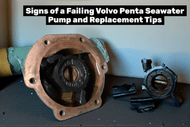Signs of a Failing Volvo Penta Seawater Pump and Replacement Tips
23rd Nov 2025
The seawater pump is a vital component of your Volvo Penta engine’s cooling system. When it starts to fail, your engine’s performance and lifespan can be at significant risk due to overheating and inefficient cooling. Recognising the warning signs early can save you from costly repairs and ensure safe boating. This guide covers the common symptoms of a failing seawater pump and practical tips for timely replacement.
Common Signs of a Failing Volvo Penta Seawater Pump
1. Rising Engine Temperature
One of the most obvious and concerning signs of a failing seawater pump is when your engine temperature gauge begins to rise beyond normal operating levels or fluctuates irregularly. The pump's impeller, which circulates cooling water through the engine, may be worn, damaged, or broken, reducing water flow. Without sufficient circulation, the engine fails to dissipate heat effectively, leading to overheating. Prolonged overheating can cause serious engine damage such as warped cylinder heads, blown gaskets, or even engine seizure, so immediate attention is critical.
2. Reduced or No Water Flow
The seawater pump expels cooling water through your boat’s exhaust system. A healthy pump produces a steady stream of water exiting at the stern. When the flow is weak, intermittent, or absent altogether, it indicates pump malfunction. This can be due to blockage, a broken impeller, or air entering the system. If you observe steam instead of water at the exhaust, or diminished water discharge soon after engine start, shut down the engine and inspect the pump immediately to avoid overheating.
3. Unusual Noises or Vibrations
If the seawater pump impeller starts to degrade or break apart, it may produce grinding, squeaking, or whining noises from the pump housing or engine vicinity. These sounds occur due to loose or misaligned impeller blades or impaired bearings. In addition to noise, you may feel abnormal vibrations distinct from normal engine hum. These symptoms flag urgent maintenance needs since ignored noises can lead to complete pump failure and engine damage.
4. Decreased Engine Performance
Overheating directly impacts engine performance. When the impeller fails, water circulation slows, prompting engine power reduction or triggering warning sensors. You might note sluggish throttle response, difficulty reaching top speeds, or an overall feeling of reduced power. These symptoms degrade your boating experience and can indicate early pump failure even before severe engine damage occurs.
5. Visible Impeller Damage
Routine inspection of the impeller is crucial. By removing the pump cover, you can visually assess the impeller blades for cracks, missing sections, or deformation. Even minor blade damage impairs water flow. The inner hub might also show wear or corrosion. If you find damaged parts during inspection, replace the entire impeller to protect your engine’s cooling.
6. Overdue Maintenance
Volvo Penta recommends scheduled impeller replacement once every year or after every 100 hours of engine use. Neglecting this maintenance accelerates pump wear and heightens the risk of sudden failure. Many pump failures can be prevented by adhering to this service interval, especially for boats operating in debris-laden or sandy waters.
Replacement Tips for Your Volvo Penta Seawater Pump
Use Genuine or High-Quality Aftermarket Parts
When replacing your Volvo Penta seawater pump, using genuine OEM parts or trusted high-quality aftermarket pumps is critical. OEM Volvo Penta pumps are designed specifically for your engine model and ensure optimal fit, reliability, and warranty coverage. Leading aftermarket brands are tested for compatibility and often provide durable corrosion-resistant materials and enhanced performance features. Choosing the right part guarantees efficient cooling and extends your engine's life.
Follow Manufacturer Guidelines
Always follow the instructions and specifications provided in your Volvo Penta engine manual. Key details include torque settings for bolts, seal installation, and the order of assembly. Incorrect installation can lead to leaks, improper cooling, or pump failure. Adhering to maintenance schedules and replacement intervals recommended by Volvo Penta helps maintain engine performance and avoid unexpected downtime.
Inspect Related Components
While replacing the seawater pump, take the opportunity to inspect related cooling system parts. Check all hoses for cracks, brittleness, or blockages. Inspect hose clamps for corrosion or looseness and replace them if necessary. Clean strainers and ensure no debris is obstructing the seawater intake. Confirm the condition of gaskets and seals and replace any that show wear. Maintaining the entire cooling system ensures efficient water flow and minimizes risk of failure.
Maintain Regular Service Intervals
Regular inspection and replacement of your seawater pump impeller usually every 12 months or 100 hours is essential. Overdue maintenance increases risk of pump and engine damage, especially if the boat operates frequently in salt or debris-laden waters. Developing a maintenance checklist and adhering to scheduled servicing keeps your engine’s cooling system functioning reliably, reduces chances of breakdowns, and prolongs overall engine life.
Frequently Asked Questions (FAQs)
Q1: How long does a seawater pump last in a Volvo Penta engine?
Typically, 1-2 years or 100 hours of operation, depending on usage and water conditions.
Q2: What causes seawater pump failures?
Common causes include dry running, debris obstruction, corrosion, and worn impellers.
Q3: Can I swap impellers without replacing the entire pump?
Yes, but if housing or shaft seal shows wear, a full pump replacement is advisable.
Q4: Why does my engine overheat even after replacing the pump?
Possible issues include blocked cooling passages, faulty thermostat, or incorrect installation.
Q5: Is aftermarket seawater pump quality comparable to OEM?
High-quality aftermarket pumps match OEM standards, but always source from trusted brands.
Conclusion
Timely recognition and replacement of failing Volvo Penta seawater pumps protect your engine from overheating and costly damage. Regular maintenance, visual inspections, and using quality parts ensure peak cooling performance, keeping your boat safe and efficient on the water.

 Australian Dollars
Australian Dollars


